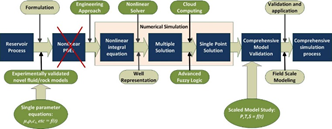
M. Enamul Hossain
Statoil Chair in Reservoir Engineering at Memorial University of Newfoundland, St. John’s, Canada
Title: Current Trends and Challenges in Reservoir Simulation
Biography
Biography: M. Enamul Hossain
Abstract
Reservoir simulation is a critical element in the development, planning and production management of oil and gas fields. The ultimate goal of reservoir simulation is to aid the decision making process throughout all stages of field life. The major sources of uncertainties are the linearization of all governing equations – a standard practice in reservoir modeling. It is currently considered that obtaining exact solutions is not achievable due to the lack of non-linear solvers. In literature, it has been shown that this assertion is not justified for most of the realistic range of petroleum parameters, even for single-phase flow. The impact of linearization is even more important for multiphase flow. Recent literature shows that few models include non-Darcy flow under multiphase flow conditions, even fewer use non-Darcy equations for dual-porosity, dual-permeability description, and none uses transition between various flow regimes within porous media and fracture networks. Further, there is a limited number of studies on non-Newtonian nature of petroleum fluids. So, there is an immense need to focus on developing new sets of mathematical models of complex reservoir rock and fluid systems that will lead to the development of more accurate, and state of the art performance prediction tools. However, challenges remains on how to solve these highly non-linear models, and validate the numerical findings through experiments. Experimentally, capturing memory is a real challenge because it cannot be visualized and tracked easily with conventional experimental practices.
Numerical solutions of non-linear equations, including considerations of time function both in fluid and rock systems, will produce multiple solutions, forming a cluster of points. Challenge remains how to tag these points with confidence. In parallel, specifically designed experimental trials will be a choice to validate these mathematical models. These models, combined with non-linear solvers that are capable of tracking multiple solutions, will possibly make the most comprehensive reservoir simulator to-date. The resulting simulator can be applied to highly heterogeneous and heavy oil reservoirs.

Recent Publications:
1. Obembe, A.D., Hossain, M.E., Mustapha, K.A. and Abu-Khamsin, S.A. (2016). A modified memory-based mathematical model describing fluid flow in Porous Media. Computers and Mathematics with Applications, in press.
2. Obembe, A.D., Hossain, M.E., and Abu-Khamsin, S.A. (2016). Variable-order derivative time fractional diffusion model for heterogeneous porous media. Journal of Petroleum Science and Engineering, in press.
3. Bin Dahbag, M.S., Hossain, M.E., and Al-Quraishi, A.A. (2016). Efficiency of Ionic Liquids as Enhanced Oil Recovery Chemical: Simulation Approach. Energy & Fuels, 2016, in press.
4. Hossain, M.E. (2016). Role of Porosity on Energy Transport with Equal Rock-Fluid Temperatures during Thermal EOR Process, Arabian Journal of Science and Engineering. DOI: 10.1007/s13369-016-2343-8, in press.
5. Hossain, M.E. and Wajheeuddin, M. (2016). The Use of Grass as an Environment-Friendly Additive in Water-Based Drilling Fluids, Petroleum Science, 13(2):292-303.

